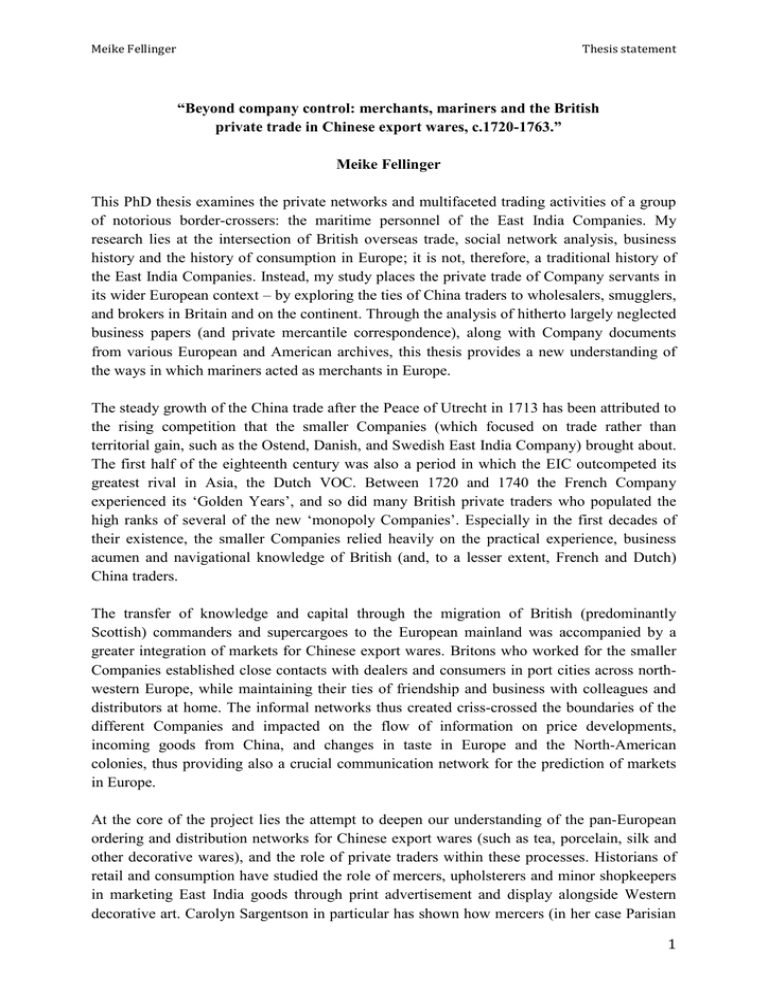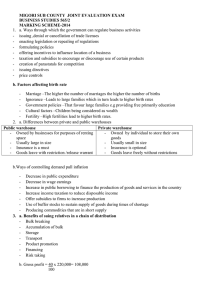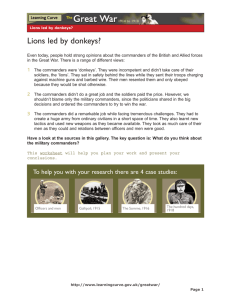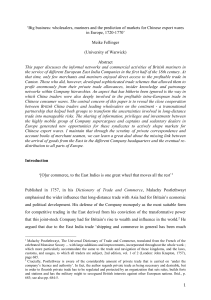“Beyond company control: merchants, mariners and the British
advertisement

Meike Fellinger Thesis statement “Beyond company control: merchants, mariners and the British private trade in Chinese export wares, c.1720-1763.” Meike Fellinger This PhD thesis examines the private networks and multifaceted trading activities of a group of notorious border-crossers: the maritime personnel of the East India Companies. My research lies at the intersection of British overseas trade, social network analysis, business history and the history of consumption in Europe; it is not, therefore, a traditional history of the East India Companies. Instead, my study places the private trade of Company servants in its wider European context – by exploring the ties of China traders to wholesalers, smugglers, and brokers in Britain and on the continent. Through the analysis of hitherto largely neglected business papers (and private mercantile correspondence), along with Company documents from various European and American archives, this thesis provides a new understanding of the ways in which mariners acted as merchants in Europe. The steady growth of the China trade after the Peace of Utrecht in 1713 has been attributed to the rising competition that the smaller Companies (which focused on trade rather than territorial gain, such as the Ostend, Danish, and Swedish East India Company) brought about. The first half of the eighteenth century was also a period in which the EIC outcompeted its greatest rival in Asia, the Dutch VOC. Between 1720 and 1740 the French Company experienced its ‘Golden Years’, and so did many British private traders who populated the high ranks of several of the new ‘monopoly Companies’. Especially in the first decades of their existence, the smaller Companies relied heavily on the practical experience, business acumen and navigational knowledge of British (and, to a lesser extent, French and Dutch) China traders. The transfer of knowledge and capital through the migration of British (predominantly Scottish) commanders and supercargoes to the European mainland was accompanied by a greater integration of markets for Chinese export wares. Britons who worked for the smaller Companies established close contacts with dealers and consumers in port cities across northwestern Europe, while maintaining their ties of friendship and business with colleagues and distributors at home. The informal networks thus created criss-crossed the boundaries of the different Companies and impacted on the flow of information on price developments, incoming goods from China, and changes in taste in Europe and the North-American colonies, thus providing also a crucial communication network for the prediction of markets in Europe. At the core of the project lies the attempt to deepen our understanding of the pan-European ordering and distribution networks for Chinese export wares (such as tea, porcelain, silk and other decorative wares), and the role of private traders within these processes. Historians of retail and consumption have studied the role of mercers, upholsterers and minor shopkeepers in marketing East India goods through print advertisement and display alongside Western decorative art. Carolyn Sargentson in particular has shown how mercers (in her case Parisian 1 Meike Fellinger Thesis statement marchants merciers) sat at a strategic position between large suppliers of goods and the local finishing trades. 1 What we cannot grasp from her and other works, however, is how the wholesale trade in Chinese consumer goods was actually organized, and how the communication between consumers and overseas traders (who procured most novelties and fine luxury wares from China) was mediated. The re-distribution of Chinese export wares following the regular Company sales is equally neglected by Company historians, whose interest in the objects of the Indies trade often ceases with the arrival of the cargo in the Company warehouses. 2 My thesis seeks to fill that void by emphasising the active participation of China traders in the wholesale, retail and special commission trade in Europe. By analysing the collaboration (and collusion) of Company supercargoes and wholesale dealers in important nodes such as Amsterdam, London, Cadiz, Gothenburg, Ostend and Hamburg, I seek to develop a more systematic account of the functioning of the commission trade while mapping the geographies of British private trade in a pan-European trading arena. The dramatis personae of this study are those maritime traders who possessed a unique set of skills, commercial experience and navigational knowledge, as they were ‘brought up’ in the merchant fleet of the East India Companies – or who joint the China trade at a later stage of their career, having worked their way up to the position of captains and supercargoes in the Atlantic, Mediterranean or intra-European coastal trades. Supercargoes of the Canton trade (who represented a curious mix between commission agent, entrepreneur and diplomat) were substantial merchants in their own right, who took on the responsibility for managing the Company business abroad. During the first half of the eighteenth century, supercargoes accompanied Company ships to China and back – thus spending less than six months at a time in Eastern ports. In recognition of their key role for the success of the Company enterprise, they were granted a share in the profit of a voyage, as well as the privilege to conduct substantial freight-free trade on their own account. Commanders who had an equally influential position on board were treated with similar respect and commercial remuneration. Given the special requirements for gaining a post in the lucrative China trade, and the direct competition between the Companies for competent personnel, there existed from the late seventeenth century a pan-European labour market for such maritime traders.3 China supercargoes, commanders, and officers formed a close-knit community with a strong professional identity and extensive links to metropolitan circles of ship-owners, insurers and bankers. 4 The amount of dining, gambling, gift-giving, and intermarrying within this 1 Carolyn Sargentson, Merchants and Luxury Markets: The Marchant Merciers of Eighteenth-Century Paris (London, 1996). 2 The lack of research on Company auctions and the inner-European and Atlantic re-distribution has contributed to the marginalisation of the privilege trade in the literature on the East India Companies. One exception is certainly the literature on tea smuggling. See, for instance, Hoh-Cheong and Lorna H. Mui, ‘Smuggling and the British Tea trade before 1784', The American Historical Review, 74:1 (1968), pp. 44-73. 3 An excellent account of the frequency by which British mariners accepted employment in other Companies is given by Conrad Gill, Merchants and Mariners of the 18th Century (Westport: Connecticut, 1961, repr. 1978). 4 On the social ties between British East India commanders in the later part of the eighteenth century see the important article by H.V. Bowen, ‘Privilege and Profit: Commanders of East Indiamen as Private Traders, 2 Meike Fellinger Thesis statement community might be seen as a social component of the sophisticated commercial collaboration that developed within these transnational collectives. Although much of the literature on the China trade still assumes an antagonism between British commanders and supercargoes, hitherto neglected archival materials on the personal networks and commercial ventures of members of both groups show a rather different picture. 5 In fact, the lines of competition and friendship were far more complex than previously thought, given the persistent focus on the ‘national’ in studies of European Company trade with the East. Instead, this study highlights the centrality of cross-Company networks and alternative modes of business organization within the larger Company infrastructure. Regional bonds and family ties were powerful among the Scottish, English and Irish China traders on the European continent, and they also helped to integrate private trade into parallel channels of distribution such as smuggling.6 A case study on a Scottish network of commanders, supercargoes and Company directors is used to shed light on the ways in which informal networks undermined the otherwise hierarchical structure of the Companies. On a theoretical as well as practical level, the study of mariners as merchants contributes to the discussion about the ambiguous relationship between Company and private trade in the first half of the eighteenth century. By focusing more in-depth on the careers and activities of individual China supercargoes and commanders (including Captain Thomas Hall, Robert Hewer, Arthur Abercromby, Charles Irvine, Captain Francis Nelly, the brothers Alexander and Abraham Hume and Colin and Hugh Campbell), this project seeks to reveal both the opportunities and constraints of private trade against the background of changing Company regulations. Despite the many restrictions on tonnage and on certain commodities that were put in place by the Companies over the course of the eighteenth century, private traders had considerable space for manoeuvring. 7 In fact, every alteration of private trade regulations created a new set of opportunities, which individual Company servants were quick to discover and use to their own advantage. It is crucial to recognize that private traders gathered information about the particular restrictions and commercial strategies of all Companies trading to China, and their investment in goods was made in response to the niches that were created by the various private trade Entrepreneurs and Smugglers, 1760-1813’, International Journal of Maritime History, XIX, No. 2 (2007), pp. 43-88. 5 The contruction of this antagonism has largely been influenced by the work of Hosea Ballou Morse, The Chronicles of the East India Company Trading to China, 1635-1834, 4 vols (Oxford, 1926) who transcribed and annotated much of the official correspondence between British supercargoes and commanders in China. The regular letters addressed to the ships’ captains warning them against running goods ashore and to retain discipline among its crew was certainly an element of this official relationship. But, it does not flesh out the private arrangements, sociability and the formation of alliances between commanders and individual supercargoes. Supercargoes are considered as loyal servants (with some spectacular exceptions) in his work. Commmanders instead are depicted as rough-hewn and self-interested men whose trading needed to be regulated and contained. 6 Smuggling ventures were widespread among British supercargoes and commanders who were working for the English, Ostend, Swedish, Danish Companies and Prussian Companies. They heavily relied on friends and families who received consignments of tea and silks in relatively remote parts of Ireland, Scotland and the Isle of Man. 7 This research focuses exclusively on the regulations set in place by the EIC, Ostend and Swedish East India Company and the reactions of British-born traders within those Companies. 3 Meike Fellinger Thesis statement regulations of other ‘monopoly Companies’ as well. Private traders assembled goods for a European, not only a domestic market, and their operations have therefore to be set within a matrix of competition that included a small group of large players (the Companies) who were relatively slow moving in their business decisions, and a larger group of small players (the individual private traders) whose salient features were flexibility, opportunism and nonspecialization. A more comprehensive treatment of the dynamic behind private and Company trade than it is currently offered, and of the various links that connected both branches of commerce, is necessary in order to come to terms with the question if the East India Companies deserve to be labelled ‘monopolists’ after all in this period. 4






